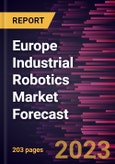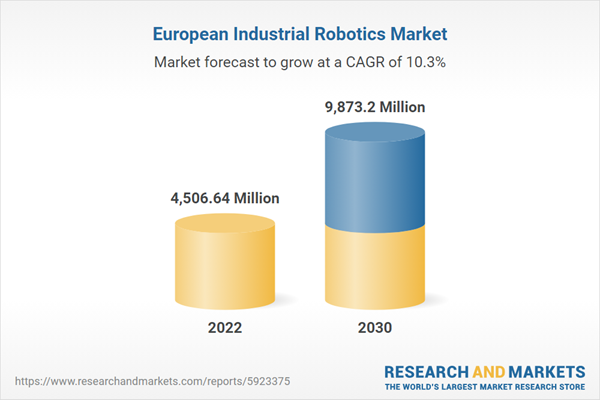The Europe industrial robotics market is expected to grow from US$ 4,506.64 million in 2022 to US$ 9,873.20 million by 2030. It is estimated to grow at a CAGR of 10.3% from 2022 to 2030.
Based on types, the Europe industrial robotics market is segmented into articulated, cartesian, SCARA, collaborative, parallel, and others. In 2022, the articulated segment registered the largest share in the Europe industrial robotics market.
Based on function, the Europe industrial robotics market is segmented into soldering and welding, material handling, assembling and disassembling, painting and dispensing, milling, and cutting and processing. In 2022, the soldering and welding segment registered the largest share in the Europe industrial robotics market.
Based on industry, the Europe industrial robotics market is segmented into automotive, medical and pharmaceuticals, electrical and electronics, rubber and plastics, metal and machinery, and food and agriculture. In 2022, the automotive segment registered the largest share in the Europe industrial robotics market.
Based on country, the Europe industrial robotics market is segmented into Germany, France, Italy, Spain, the UK, Sweden, Belgium, Netherlands, and the Rest of Europe. In 2022, Germany registered the largest share in the Europe industrial robotics market.
ABB Ltd, Comau SpA, Fanuc Corp, Kawasaki Heavy Industries Ltd, Kuka AG, Mitsubishi Electric Corp, Seiko Epson Corp, Staubli International AG, Universal Robots AS, and Yaskawa Electric Corp are some of the leading companies operating in the Europe industrial robotics market.
Reasons to Buy
Sustainability and Green Economy Drives Europe Industrial Robotics Market
Sustainability and environmental considerations are anticipated to be vital trends in the Europe industrial robotics market. Industrial robots are being designed to be more energy efficient with improved power management systems and energy-saving features. In coming years, the robotics sector will focus on developing energy-efficient robots that would help companies lower their carbon footprint and achieve sustainability goals. Industrial robots can also improve material efficiency, optimize processes, and reduce waste. Additionally, advancements in recycling robot components and materials can reduce the industry's environmental impact. Industrial robotics are expected to involve green manufacturing practices to reduce the use of hazardous substances and minimize emissions. Manufacturers would be able to explore the usage of eco-friendly materials and sustainable design principles by introducing industrial robots. This will include selecting materials with lower environmental impact. By embracing sustainability and environmental considerations, the Europe industrial robotics market can contribute to a more sustainable manufacturing sector. These above-mentioned future trends will drive the development of more environment friendly robotics systems aligning with global efforts toward a greener and more sustainable future.Europe Industrial Robotics Market Overview
The Europe industrial robotics market is segmented into Germany, France, the UK, Italy, Spain, Sweden, Belgium, the Netherlands, and the Rest of Europe. In European Union, Germany is a highly automated economy. In 2020, the country had ~230,000 industrial robots. In 2020 alone, manufacturing facilities in Germany installed 22,300 new industrial robots. According to the International Federation of Robotics (IFR), Germany accounts for 33% of overall Europe's robot inventory. The number of robots in German manufacturing facilities is more than three times compared to Italy, which has 78,200 industrial robots. Similarly, in 2020, France had ~44,800 industrial robots, whereas the UK accounted for 23,000 industrial robots. The growing use of robots in manufacturing, alongside humans, is easing manufacturing operations and increasing production volume. Thus, the manufacturing facilities across the region are constantly eyeing on adopting newer, technologically advanced robotic solutions. This parameter is a key driving force in the Europe industrial robotics market in Europe. The digital industrial revolution, i.e., Industry 4.0, is helping increase operational flexibility in manufacturing sector for mass customization, increased speed of workflows, better quality of final products, and improved productivity in factories. According to IFR, the total installation of industrial robots across the region increased by 15% in 2021 compared to 2020. Because of this, automotives chemicals, food & beverages, mechanical engineering, and electronics sectors are installing industrial robots to increase productivity. In 2021, the installation of industrial robot installations in Europe regained growth after two years of decline due to the rising demand from various industrial sectors. For instance, in 2021, the installation of industrial robots in metal & machinery and plastics & chemical products rose strongly by 50% and 30%, respectively, compared to 2018. Thus, the rising adoption of automation solutions further boosts the Europe industrial robotics market growth. Governments of various countries are investing in automating the manufacturing business in the region. For instance, in July 2021, the government of the UK announced an investment of US$ 59.3 million (GBP 53 million) to drive the development of digital manufacturing technologies. Out of which, US$ 28.10 million (GBP 25 million) will be invested in setting up five new industry-sponsored research centers to accelerate the development of cutting-edge digital solutions that can transform manufacturing businesses. The remaining amount will be invested in a digital supply chain innovation hub and provided to 37 individual projects to digitalize and transform manufacturing supply chains. Thus, the growing government support to boost automation will further boost the growth of the Europe industrial robotics market.Europe Industrial Robotics Market Revenue and Forecast to 2030 (US$ Million)
Europe Industrial Robotics Market Segmentation
The Europe industrial robotics market is segmented into types, function, industry, and country.Based on types, the Europe industrial robotics market is segmented into articulated, cartesian, SCARA, collaborative, parallel, and others. In 2022, the articulated segment registered the largest share in the Europe industrial robotics market.
Based on function, the Europe industrial robotics market is segmented into soldering and welding, material handling, assembling and disassembling, painting and dispensing, milling, and cutting and processing. In 2022, the soldering and welding segment registered the largest share in the Europe industrial robotics market.
Based on industry, the Europe industrial robotics market is segmented into automotive, medical and pharmaceuticals, electrical and electronics, rubber and plastics, metal and machinery, and food and agriculture. In 2022, the automotive segment registered the largest share in the Europe industrial robotics market.
Based on country, the Europe industrial robotics market is segmented into Germany, France, Italy, Spain, the UK, Sweden, Belgium, Netherlands, and the Rest of Europe. In 2022, Germany registered the largest share in the Europe industrial robotics market.
ABB Ltd, Comau SpA, Fanuc Corp, Kawasaki Heavy Industries Ltd, Kuka AG, Mitsubishi Electric Corp, Seiko Epson Corp, Staubli International AG, Universal Robots AS, and Yaskawa Electric Corp are some of the leading companies operating in the Europe industrial robotics market.
Reasons to Buy
- Save and reduce time carrying out entry-level research by identifying the growth, size, leading players, and segments in the Europe industrial robotics market.
- Highlights key business priorities in order to assist companies to realign their business strategies
- The key findings and recommendations highlight crucial progressive industry trends in the Europe industrial robotics market, thereby allowing players across the value chain to develop effective long-term strategies
- Develop/modify business expansion plans by using substantial growth offering developed and emerging markets
- Scrutinize in-depth Europe market trends and outlook coupled with the factors driving the industrial robotics market, as well as those hindering it
- Enhance the decision-making process by understanding the strategies that underpin commercial interest with respect to client products, segmentation, pricing, and distribution
Table of Contents
1. Introduction
3. Research Methodology
4. Europe Industrial Robotics Market Landscape
5. Europe Industrial Robotics Market- Key Market Dynamics
6. Industrial Robotics Market- Europe Analysis
7. Europe Industrial Robotics Market Analysis - By Types
8. Europe Industrial Robotics Market Analysis - By Function
9. Europe Industrial Robotics Market Analysis - By Industry
10. Europe Industrial Robotics Market- Country Analysis
11. Industry Landscape
12. Company Profiles
13. Appendix
List of Tables
List of Figures
Companies Mentioned
- ABB Ltd
- Comau SpA
- Fanuc Corp
- Kawasaki Heavy Industries Ltd
- Kuka AG
- Mitsubishi Electric Corp
- Seiko Epson Corp
- Staubli International AG
- Universal Robots AS
- Yaskawa Electric Corp
Table Information
| Report Attribute | Details |
|---|---|
| No. of Pages | 203 |
| Published | October 2023 |
| Forecast Period | 2022 - 2030 |
| Estimated Market Value in 2022 | 4506.64 Million |
| Forecasted Market Value by 2030 | 9873.2 Million |
| Compound Annual Growth Rate | 10.3% |
| Regions Covered | Europe |
| No. of Companies Mentioned | 10 |









